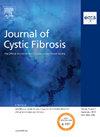WS09.02Intestinal current measurement detects age-dependent differences in CFTR function in rectal epithelium
IF 6
2区 医学
Q1 RESPIRATORY SYSTEM
引用次数: 0
Abstract
Objective
Intestinal current measurement (ICM) provides a sensitive bioassay for assessment of CFTR function in rectal biopsies ex vivo. Results from clinical trials of CFTR modulators across age groups indicate that CFTR function in the sweat duct may be age-dependent with children reaching higher levels than adults. However, little is known about age dependency of CFTR function in the intestinal epithelium.
Methods
We investigated CFTR-mediated chloride secretion in rectal biopsies from 258 people without CF and 72 people with pancreatic-insufficient CF from 1 month to 68 years of age with ICM. Furthermore, morphometric analysis of epithelial cells lining the crypts and surface of the rectal mucosa were performed.
Results
We found that CFTR-mediated chloride secretion across rectal tissues, as determined from cAMP-mediated as well as cholinergic chloride-secretory responses was highest during infancy and early childhood and declined with age in people without CF. In people with CF, potassium-secretory responses induced by cholinergic stimulation were also reduced with increasing age. Morphometric analyses demonstrated that CFTR expressing colonocytes at the crypt base were decreased with age. A secondary analysis of the ICM data of our previous studies on the effects of lumacaftor/ivacaftor on CFTR function in F508del -homozygous people with CF aged 12 years and older and 2 to 11 year old children showed correlations of the change in cAMP-mediated and cholinergic chloride secretory response with the age of people with CF.
Conclusion
These results demonstrate that CFTR function in the rectal epithelium is reduced with increasing age and indicate that this change is likely due to a decline in the number of secretory colonocytes at the crypt base. These findings suggest that differences in CFTR expressing cells may explain increased functional responses to CFTR modulator therapies in children compared to adult people with CF.
[09.02]肠电流测量检测直肠上皮CFTR功能的年龄依赖性差异
目的肠电流测量(ICM)为体外直肠活检中CFTR功能的评估提供了一种灵敏的生物测定方法。跨年龄组CFTR调节剂的临床试验结果表明,CFTR在汗管中的功能可能与年龄有关,儿童的CFTR水平高于成人。然而,对肠上皮中CFTR功能的年龄依赖性知之甚少。方法对258例非CF患者和72例胰腺功能不全CF患者(1个月~ 68岁)的ICM患者的直肠活检中cftr介导的氯离子分泌进行了研究。此外,对隐窝和直肠粘膜表面的上皮细胞进行了形态计量学分析。结果我们发现cftr介导的氯离子分泌在直肠组织中,通过camp介导的氯离子分泌和胆碱能分泌反应来确定,在婴儿期和幼儿期最高,在没有CF的人群中随着年龄的增长而下降。在CF患者中,胆碱能刺激引起的钾分泌反应也随着年龄的增长而减少。形态计量学分析表明,在隐窝基部表达CFTR的结肠细胞随着年龄的增长而减少。ICM的二次分析数据我们的先前的研究的影响lumacaftor / ivacaftor雌性生殖道功能F508del纯合子的CF患者12岁以上和2到11岁的孩子cAMP-mediated显示相关性的变化和氯化胆碱能分泌反应与人的年龄与直肠上皮CF.ConclusionThese结果表明,雌性生殖道功能随着年龄的增长而降低,表明这种变化可能是由于隐窝基部分泌性结肠细胞数量减少。这些发现表明,CFTR表达细胞的差异可能解释了CF儿童患者对CFTR调节剂治疗的功能反应比成人CF患者增加。
本文章由计算机程序翻译,如有差异,请以英文原文为准。
求助全文
约1分钟内获得全文
求助全文
来源期刊

Journal of Cystic Fibrosis
医学-呼吸系统
CiteScore
10.10
自引率
13.50%
发文量
1361
审稿时长
50 days
期刊介绍:
The Journal of Cystic Fibrosis is the official journal of the European Cystic Fibrosis Society. The journal is devoted to promoting the research and treatment of cystic fibrosis. To this end the journal publishes original scientific articles, editorials, case reports, short communications and other information relevant to cystic fibrosis. The journal also publishes news and articles concerning the activities and policies of the ECFS as well as those of other societies related the ECFS.
 求助内容:
求助内容: 应助结果提醒方式:
应助结果提醒方式:


